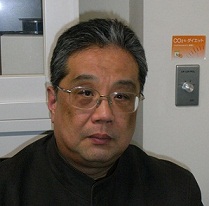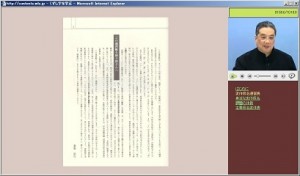01-01. Implementing a Rational Curriculum with Full On-Demand Courses
Nobuyuki Kanechiku
Professor, Faculty of Letters, Arts and Sciences
Two new schools — the School of Culture, Media and Society and the School of Humanities and Social Sciences — were created in April 2007 through a reorganization at the Faculty of Letters, Arts and Sciences. Because this reorganization dovetailed exactly with the official release of Course N@vi, the Faculty of Letters, Arts and Sciences has been actively promoting the adoption of Course N@vi from the outset at these new schools.
Full on-demand lectures created for the “basic lectures” portion of first-year required subjects
The two newly created schools employ a one-three system, in which students receive basic education in their first year followed by three years in a specialized program in their second, third, and fourth years. The first-year basic education program consists of “basic lectures” and “basic seminars.”
The basic lectures portion is made up of catalog-like lectures that introduce the material taught in the School of Culture, Media and Society’s six disciplines and the School of Humanities and Social Sciences’ 17 courses in the second and subsequent years. In effect, these lectures are intended to give students an introduction to each field while providing them with information to help them select their major. All basic lectures are offered as full on-demand lectures on Course N@vi.
Each basic lecture is recorded as a video just under 30 minutes long and uploaded to Course N@vi. Students select the lectures they are interested in and watch them on their computer at home or elsewhere. Students are required to enter their impressions on a review sheet after taking each lecture and are obliged to take at least two-thirds of the lectures within the term. After taking the lectures, students submit a report on one of the lectures via Course N@vi and, if the report is recognized, obtain a credit.
Because basic lectures are run entirely through Course N@vi, faculty members and students do not meet face to face. Initially, there were concerns that many students would drop out, but Professor Kanechiku has found that, in fact, 97 percent of students obtain credits, which is an exceptionally high percentage.
“Things have gone very well partly because the new schools were launched at the same time Course N@vi came online. If we had to teach the same lectures in physical classes, the classroom arrangements would have been a nightmare. Without Course N@vi, running this curriculum would probably be impossible.”
The School of Culture, Media and Society runs 56 basic lectures and the School of Humanities and Social Sciences 53, both huge numbers. That the schools can offer this many lectures is because they are on-demand. The advantage for the students is that they can take the lectures when they like without any timetable or scheduling limitations, so they are free to choose the lectures they truly want from a broad range of topics.
Another merit of Course N@vi is that content, once created, can be reused. Basic lectures that do not change from year to year can be used again as is. And if needed, lectures can be revised or added to easily.
On the Toyama Campus, on-demand courses have been actively encouraged from the very beginning with the adoption in 2001 by the Toyama Research Center (TRC) of the Academic Frontier Project, a project under the Ministry of Education, Culture, Sports, Science and Technology’s academic research advancement program. Part of the campus’s push for on-demand courses was a strong recognition that such courses could help to accommodate the students enrolled in the School of Letters, Arts and Sciences II, an evening-only school, who cannot visit the campus during the day.
Because of these circumstances, the Toyama Campus was much farther along the curve with on-demand courses than other schools when Course N@vi was rolled out. Leveraging this know-how, the campus made the decision to make all basic lectures full on-demand.
Course N@vi is used extensively in basic seminars as well
Course N@vi is used in basic seminars, the other main aspect of basic education for first-year students.
The purpose of the basic seminars is for students to acquire basic academic literacy, including reading and writing proficiency, research proficiency, and presentation and article writing proficiency. For language study classes, full-time faculty members are placed in charge of instructing units of 30 or so students.
All seminar courses follow a standardized schedule and curriculum. For texts, full-time Faculty of Letters, Arts and Sciences staff members contribute articles on their field of study in keeping with the first-year curriculum and stockpile these on an online database. The faculty member of each course can order printed texts as needed.
Students can search the database by topic and keyword for articles of interest and incorporate various articles selected from the database into their studies. So while the actual courses are taught in classrooms, the materials and prints distributed in class can be downloaded from Course N@vi and reports and coursework are submitted via Course N@vi.
By recording marks in Course N@vi, faculty members can have the system automatically tally marks and determine final grades. While there are some differences in application between faculty members, overall, the Course N@vi system has been extensively incorporated into basic seminars.
“Managing everything online saves me from having to haul reports around. I can do some marking at the university, update the system, and do the remainder at home. Because the system is paperless, I don’t have to worry about losing reports or think about where things are stored.”
With Course N@vi fully integrated into the basic lectures and basic seminars of first-year required subjects, all students at Toyama Campus who have been admitted since the curriculum was introduced have had to use Course N@vi. Consequently, it has been possible to pinpoint problems if a student has no access history.
Students have accepted the system as a matter of course because they cannot obtain credits without using it. “Today’s students have taken courses in information at high school and are well-versed in computers. If they understand what the Course N@vi system is all about from the start, they have no issues with using it.”
Extending the full on-demand system to examinations
Professor Kanechiku uses full on-demand lectures in several other courses as well. The content includes lectures recorded specifically for on-demand use in a studio and previous year’s lectures that have been recorded and edited.
For example, in a course on learning cursive scripts, students are asked to study the textbooks before taking the on-demand lectures. What is more interesting about this course is that the final exam is also conducted on Course N@vi. Although a time limit is put on answering the exam, students are free to access the exam anytime on exam day. “There were concerns that examinations outside of the classroom would lead to rampant cheating or that students would get better students to help them with the answers. But we found after implementing these examinations the mark distributions were no different from past in-class examinations. I was pleasantly surprised by how ethical our students actually are.”
Professor Kanechiku also uses Course N@vi in these courses to determine report submissions, attendance records, and final grades. “I have 450 students. Grading them with Course N@vi is a huge labor saver. Using Course N@vi has been a great help, especially when the deadline for final grades is 10 days late.”
“Naturally, there are subjects suited to on-demand courses and those that are not. I’m not saying everything should be on-demand, but where on-demand offers benefits, why not take advantage of it?”
Huge role in information sharing among faculty members
While using Course N@vi actively in his courses, Professor Kanechiku began to think of applications for the system beyond coursework.
Examples include posting faculty meeting materials on the system with access privileges limited to faculty members and distributing materials among all faculty members, such as various announcements or minutes from important meetings. The system also allows for systematic management of past materials. “When we reorganized the faculty, we were having meetings all over the place and there were worries it would get out of control. By using this system, it was thought we could share all of this information. Even if all faculty members did not have to see all materials, it was important that the information was arranged in such a way that they could access what they wanted to see anytime.”
Professor Kanechiku also uses Course N@vi as a joint research platform between faculty members. For a collaborative research group of 13 professors from around the country, Professor Kanechiku has registered professors from other universities as guests on the system and posts various research matters on Course N@vi. “The system allows me to effortlessly share research information in a paperless format and, in some cases, leads to comments and discussions.”
Course N@vi does not have any custom functions for research use, but as this example indicates, it has potential applications in a broad spectrum of areas.
<playback window of an on-demand lecture>
Students can take lectures recorded for on-demand use at the time and location of their choosing.



